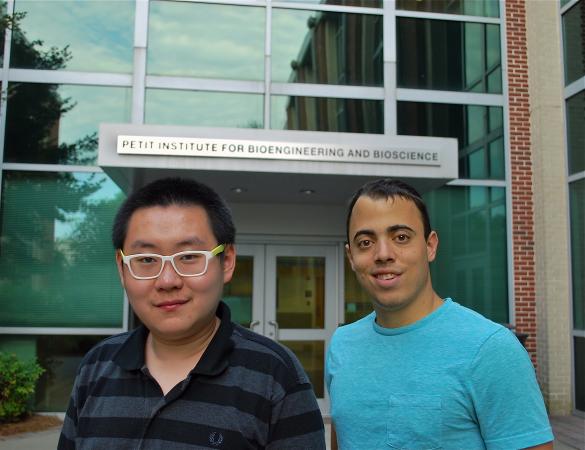Robert Mannino and Yichen “Payne” Wang are like a couple of MacGyvers in the realm of scientific research. Like the famous TV secret agent, they’ve managed to address a complex problem with ordinary items. The only thing missing in their bag of solutions is a Swiss Army Knife.
Wang is a Petit Undergraduate Research Scholar in the lab of Wilbur Lam, and Mannino, a grad student and a former Petit Scholar, is his mentor. The two biomedical engineering students, with a team of researchers in the Petit Institute for Bioengineering and Bioscience, have created a way to investigate biophysical cellular interactions in the circulation system using common, off-the-shelf lab materials.
“For the last five years our lab has focused on developing fake blood vessels, so to speak, for research,” says Lam, assistant professor in the Coulter Department of Biomedical Engineering (a joint department of Emory University and the Georgia Institute of Technology). “We’ve developed a platform technology in which we use microfabrication technologies to make these in vitro models of blood vessels.”
Essentially, they use the same technologies that computer engineers and the software and computer hardware industries use to make microfluidics. Lam’s group developed a process in which they grow endothelial cells (the interior surface of blood vessels and lymphatic vessels) in really small channels to allow cellular biophysics experimentation in an in vitro setting.
“The process is not trivial,” says Mannino, who as an undergrad started thinking about a simpler process to meet the same complicated needs, “to make these systems more accessible to biologists and cardiovascular researchers who are really interested in questions of how different blood systems interact with each other and with the endothelium.”
This kind of research traditionally takes expensive equipment and engineering expertise in microfabrication. But now, researchers who want to understand biophysical cellular reactions and their relation to health and/or disease have a more user-friendly path to enlightenment. “Rob came up with a brilliant technique which really only requires some silicone and some wire,” says Lam.
The research team has recently published the recipe in the journal Nature: Scientific Reports, a paper entitled, “Do-it-yourself in vitro vasculature that recapitulates in vivo geometries for investigating endothelial-blood cell interactions.” In addition to Mannino (the lead author), Wang and Lam, the team of multidisciplinary authors/researchers includes David R. Myers (postdoc in the Lam lab, and Mannino’s former Petit Scholar mentor), Byungwook Ahn (former postdoc in the Lam lab), Margo Rollins (pediatric hematologist/oncology fellow at Children’s Healthcare of Atlanta), Hope Gole (former postdoc in the Lam lab), Angela Lin (research engineer in the Bob Guldberg lab), Bob Guldberg (executive director of the Petit Institute, professor in the Woodruff School of Mechanical Engineering), Don Giddens (Dean Emeritus of the Coulter Department), and Lucas Timmins (former postdoc in the Timmins lab).
“This process is accessible to biologists, not just experienced engineers, and it effectively enables us to observe the process by which the blood cells and endothelial cells function together in the human body” says Wang.
One driving factor in the research, according to Mannino, was economics. “We’ve reduced the time it takes and also the cost,” he says.
And now Wang, the Petit Scholar, is taking the research to the next step. “He’s studying sickle cell biomechanics,” Mannino says. “Basically, this will be the first practical application of the device.”
Wang will leverage the advantages of the system Mannino conceived, “towards questions that really couldn’t be answered with any other type of device,” Lam says. “This kind of system is great for asking questions related to biophysics and how these cell interactions occur in normal processes and how they go awry in diseased processes.”
Using the new system, Wang can make a model of an artificial blood vessel, with tight control of the geometry and curvature, and investigate how endothelial cells pathologically respond. This is important stuff, because while we know that blood vessels in sickle cell disease are, in fact, diseased, putting patients at risk for stroke, we really don’t understand why.
“So Payne is essentially asking this biophysical question of, how does the shape or curvature or the geometry of the blood vessel itself affect these cellular interactions in sickle cell disease and only an in vitro system like this can we answer that question. These experiments can’t be conducted in vivo as there are too many other confounding issues,” says Lam, also a physician with Children’s Healthcare of Atlanta.
Wang is planning to present his research later this year at the Biomedical Engineering Society annual meeting in October, and also at the American Society of Hematology annual meeting in December. He says the Petit Scholarship experience is making it possible.
“The Petit Scholarship has provided me the opportunity to carry on with my project,” says Wang. “And there’s still a lot to be discovered in this area, a lot more work to do.”
CONTACT:
Jerry Grillo
Communications Officer II
Parker H. Petit Institute for
Bioengineering and Bioscience
Media Contact
Jerry Grillo
Communications Officer II
Parker H. Petit Institute for
Bioengineering and Bioscience
Keywords
Latest BME News
Jo honored for his impact on science and mentorship
The department rises to the top in biomedical engineering programs for undergraduate education.
Commercialization program in Coulter BME announces project teams who will receive support to get their research to market.
Courses in the Wallace H. Coulter Department of Biomedical Engineering are being reformatted to incorporate AI and machine learning so students are prepared for a data-driven biotech sector.
Influenced by her mother's journey in engineering, Sriya Surapaneni hopes to inspire other young women in the field.
Coulter BME Professor Earns Tenure, Eyes Future of Innovation in Health and Medicine
The grant will fund the development of cutting-edge technology that could detect colorectal cancer through a simple breath test
The surgical support device landed Coulter BME its 4th consecutive win for the College of Engineering competition.








